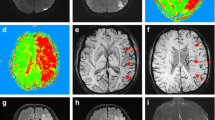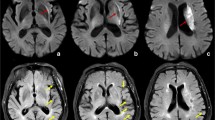Abstract
We carried out baseline and short-term follow-up MRI, including perfusion-weighted imaging (PWI) and tests of neurologic and cognitive function on 15 consecutive patients with large-vessel ischemic stroke who showed a persistent large perfusion-diffusion mismatch at enrollment up to seven days after the onset of symptoms. Of these, ten underwent induced blood pressure elevation with phenylephrine and oral medications (in eight) or intravenous fluids (in two) with the goal of improving perfusion; five had no such treatment. Significant functional improvement was defined by a reduction of 3 or more points on the NIH stroke scale (NIHSS). Significant improvement in perfusion was defined by a reduction in the volume of hypoperfused brain by 30 cc on PWI using time-to-peak (TTP) maps, without enlargement of the infarct. There was a strong, statistically significant association between improved function and improved perfusion: six (75%) of eight patients who improved in function, but none of the seven who did not, showed a reduction in volume of hypoperfused brain. All six patients who met the perfusion goal, and only two (22%) of nine who did not showed significant functional improvement (Fisher’s exact: P <0.01). There were no differences between patients who improved functionally and those who did not with respect to age, initial volume of abnormality on DWI or PWI, initial NIHSS, or changes on DWI. These findings indicate that reduction in volume of hypoperfused brain on PWI is a marker of response to treatment to improve perfusion even in subacute stroke and that partial reperfusion of regions of salvageable but dysfunctional tissue is a mechanism of improved function associated with induced blood pressure elevation.



Similar content being viewed by others
References
Lutsep HL, Albers GW, DeCrespigny A, Kamat GN, Marks MP, Moseley ME (1997) Clinical utility of diffusion-weighted magnetic imaging in the assessment of ischemic stroke. Ann Neurol 41: 574–580
Beauchamp N, Bryan RN (1998) Acute cerebral ischemic infarction: a pathophysiologic review and radiologic perspective. Am J Roentgenol 171: 73–84
Fisher M, Albers GW (1999) Applications of diffusion-perfusion magnetic resonance imaging in acute ischemic stroke. Neurol 52: 1750–1756
Sorensen AG, Buonanno FS, Gonzalez RG, et al (1996) Hyperacute stroke: evaluation with combined multisection diffusion-weighted imaging and hemodynamically-weighted echo-planar MR imaging. Radiology 199: 391–401
Skyhøj Olsen T, Bruhn P, Oberg RG (1986) Cortical hypoperfusion as a possible cause of “subcortical aphasia”. Brain 106: 393–410
Powers, WJ (1993) Acute hypertension after stroke: the scientific basis for treatment decisions. Neurology 43: 461–467
Baron JC, Marchal G (2000) Functional imaging in vascular disorders. In: Mazziotta JC, Toga AW, Frackowiak RSJ (eds) Brain mapping: the disorders. Academic Press, San Diego, pp 299–311
Hakim AM (1998) Ischemic penumbra: the therapeutic window. Neurology 51: S44-S46
Schellinger PD, Fiebach JB, Jansen O, et al (2001) Stroke magnetic resonance imaging within 6 hours after onset of hyperacute cerebral ischemia. Ann Neurol 49: 460–469
Sunshine, JL, Tarr RW, Lanzieri CF, Landis DMD, Selman WR, Lewin JS (1999) Hyperacute stroke: ultrafast MR imaging to triage patients prior to therapy. Radiology 212: 325–332
Schlaug G, Benfield A, Baird AS, et al (1999) The ischemic penumbra operationally defined by diffusion and perfusion MRI. Neurology 53: 1528–1537
Barber PA, Darby DG, Desmond PM, et al (1998) Prediction of stroke outcome with echoplanar perfusion- and diffusion-weighted MRI. Neurology 51: 418–426
Hillis AE, Barker PB, Beauchamp NJ, Gordon, B, Wityk RJ (2000) MR perfusion imaging reveals regions of hypoperfusion associated with aphasia and neglect. Neurology 55: 782–788
Jacobs MA, Simpson C, Giugni E, et al (in press) MR perfusion imaging in acute stroke: comparison of time to peak and mean transit time. Stroke 33: 367 [abstract]
Parsons MW, Yang, Q, Barber PA, et al (2000) MR perfusion imaging: acute rCBF is more accurate than rMTT or rCBV in prediction of infarct size. Stroke 31: 275
Wityk RJ, Hillis AE, Beauchamp N, Aldrich E, Barker P (2000) Mismatch of diffusion-perfusion weighted MRI in stroke patients beyond 48 hours. Neurology 54 [Suppl 3]: A474 [abstract]
Hillis AE, Barker PB, Beauchamp NJ, Winters BD, Mirski M, Wityk RJ (2001) Restoring blood pressure reperfused Wernicke’s area and improved language. Neurology 56: 670–672
Alberts MJ (1999) tPA in acute ischemic stroke. Neurology 51 [Suppl 3]: S53–S55
Wise G, Sutter R, Burkholder J (1972) The treatment of brain ischemia with vasopressor drugs. Stroke 3: 135–140
Rordorf G, Cramer SC, Efird JT, Schwamm LH, Buonanno F, Koroshetz W (1997) Pharmacological elevation of blood pressure in acute stroke. Stroke 28: 2133–2138
Rordorf G, Koroshetz W., Ezzeddine MA, Segal AZ, Buonanno FS (2001) A pilot study of drug-induced hypertension for treatment of acute stroke. Neurology 56: 1210–1213
Astrup J, Symon L, Branston NM, Lassen NA (1977) Cortical evoked potential and extracellular K+ and H+ at critical levels of brain ischemia. Stroke 8: 51–57
Skyhøj Olsen T, Larsen B, Herning M, Skriver EB, Lassen N (1983) Blood flow and vascular reactivity in collaterally perfused brain tissue. Stroke 14: 332–401
Wityk RJ, Pessin MS, Kaplan RF, Caplan LR (1994) Serial assessment of acute stroke using the NIH stroke scale. Stroke 25: 362–365
Hillis AE, Kane A, Tuffiash E, et al (in press) Reperfusion of specific brain regions by raising blood pressure restores selective language functions in subacute stroke. Brain Lang 79: 495–510
Heiss WD (1983) Flow thresholds for functional and morphological damage of brain tissue. Stroke 14: 329–331
Nakano S, Kinoshita K, Jinnouchi S, Hoshi H, Watanabe K (1989) Critical cerebral blood flow thresholds studied by SPECT using xenon-133 iodoamphetamine. J Nucl Med 30: 337–342
Buell U, Braun H, Ferert A, Stirner H, Weiller C, Ringlestein EB (1988) Combined SPECT imaging of regional cerebral blood flow (99mTc-hexemthyl-propyleneamine oxime, HMPAO) and blood volume (99mTc-RBC) to assess regional cerebral perfusion reserve in patients with cerebrovascular disease. Nuklearmedizin 27: 51–56
Lassen NA, Andersen AR (1988) Technetium-99 compounds for measurement of cerebral blood flow. J Nucl Med 29: 1464–1465
Hossmann KA (1994) Viability thresholds and the penumbra of focal ischemia. Ann Neurol 36: 557–565
Marks MP, Tong DC, Beaulieu C, Albers GW, de Crespigny A, Moseley ME (1999) Evaluation of early reperfusion and IV tPA therapy using diffusion- and perfusion-weighted MRI. Neurology 52: 1792–1798
Rordorf G, Koroshetz WJ, Copen WA, et al (1998) Regional ischemia and ischemic injury in patients with acute middle cerebral artery stroke as defined by early diffusion-weighted and perfusion-weighted MRI. Stroke 29: 939–943
Ackerman RH, Correia JA, Alpert NM, et al (1981) Positron imaging in ischemic stroke disease using compounds labeled with oxygen-15. Arch Neurol 38: 537–543
Baron JC, Bousser MG, Comar D, Castaigne P (1981) Reversal of focal “misery-perfusion syndrome” by extra-intracranial arterial bypass in hemodynamic cerebral ischemia: a case study with15O positron tomography. Stroke 12: 454–459
Wise RJS, Bernardi S, Frackowiak RSJ, Legg NJ, Jones T (1983) Serial Observations on the pathophysiology of acute stroke. The transition from ischaemia to infarction as reflected in regional oxygen extraction. Brain 106: 197–222
Marchal G, Serrati C, Rioux P, et al (1993) PET imaging of cerebral perfusion and oxygen consumption in acute ischemic stroke: Relation to outcome. Lancet 341: 925–927
Marchal G, Rioux P, Serrati C, et al (1995) Value of acute-stage PET in predicting neurological outcome after ischemic stroke: Further assessment. Stroke 26: 524–525
Derdeyn CP, Yundt KD, Videen TO, Carpenter DA, Grubb RL, Powers WJ (1998) Increased oxygen extraction fraction is associated with prior ischemic events in patients with carotid occlusion. Stroke 29: 754–758
Acknowledgements
The research reported in this paper was supported by an NIH grant, K23 DC00174-01 (to A.H.), the Charles A. Dana Foundation (grant to A.H.), and the Rodgers-Wilbur Foundation (gift to R.W.).
Author information
Authors and Affiliations
Corresponding author
Rights and permissions
About this article
Cite this article
Hillis, A.E., Wityk, R.J., Beauchamp, N.J. et al. Perfusion-weighted MRI as a marker of response to treatment in acute and subacute stroke. Neuroradiology 46, 31–39 (2004). https://doi.org/10.1007/s00234-002-0918-4
Published:
Issue Date:
DOI: https://doi.org/10.1007/s00234-002-0918-4




